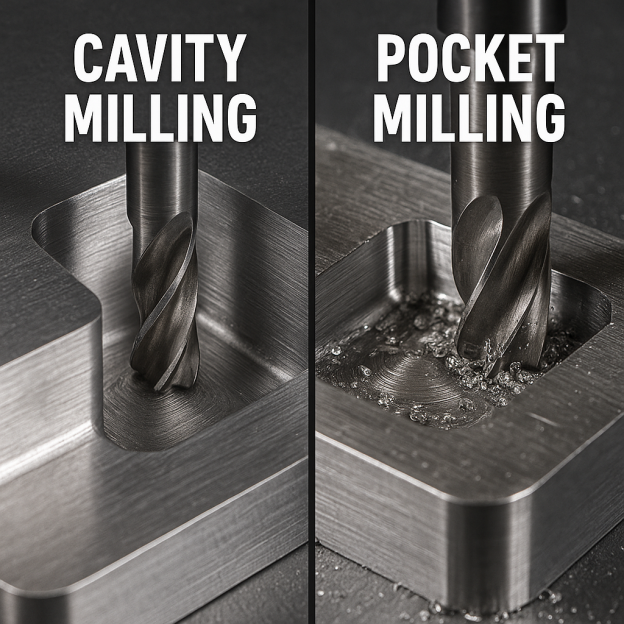Cavity Milling Guide: Strategies, Tools, and CAM Tactics
 Jun 17,2025
Jun 17,2025

Let's talk cavity milling - the CNC process that creates precision hollows in everything from aluminium to titanium. While 60% of mould makers depend on it, tool deflection and chip issues can slow you down. Want to cut cycle times by 40% and triple tool life while hitting Ra 0.4 µm finishes? We'll show you how through smart tool choices, CAM tricks, and 5-axis solutions.
What is Cavity Milling?
Cavity milling creates those precise hollow spaces in moulds, aerospace parts, and medical implants you need. While surface milling skims the top, cavity work demands smart depth control, long-reach tools, and chip management to nail those tight internal geometries.
How Cavity Milling Works
The working of cavity milling is discussed step-by-step in this section:
1.Tool Engagement:
- A rotating end mill plunges into the material (axial cutting) or moves laterally (radial cutting) to carve out material layer by layer.
- Step-down depth(e.g., 0.5-2mm per pass) depends on material hardness and tool rigidity.
2. Material Removal:
- Roughing passes use high feed rates and deep cuts to remove bulk material.
- Finishing passes employ light step-overs (5-10% of tool diameter) for smooth walls.
3.Chip Evacuation:
- Compressed air or through-tool coolant clears chips from deep cavities to prevent recutting and tool wear.
Its key features include adaptability for complex designs, precision and efficiency.
Cavity Milling vs. Pocket Milling

Cavity milling machines deep internal spaces; pocket milling creates shallow recesses.
|
Feature |
Cavity Milling |
Pocket Milling |
|
Tool Reach |
Requires long-reach tools (10xD or more) to machine deep cavities |
Uses standard tools (3- 5xD) since pockets are shallower |
|
Chip Evacuation |
Challenging - chips get trapped in deep cavities, requiring an air blast or through-tool coolant |
Easier - open design allows chips to escape naturally |
Typical Industries and Parts Examples
Cavity milling excels in precision industries. Three key examples demonstrate its impact on efficiency, tool life, and surface quality.
Typical Industries and Part Examples:
1.Aluminium Mould Core
- Achievement:Cycle time reduced by 40%
- Method:Optimised toolpaths and high-efficiency roughing
2.Inconel Aerospace Housing
- Achievement:Tool life tripled
- Method:High-Speed Machining (HSM) strategies
3.Medical Implant Pocket
- Achievement:Achieved Ra 0.4 µm surface finish
- Method:Precision finishing paths with micro-grain tools
Common Challenges in Deep-Cavity Work
Deep-cavity machining presents unique hurdles affecting precision and efficiency. You'll face tool accessibility, stability, and chip management issues that impact surface finish and tool life. Recognising these helps select proper strategies for success.
1. Limited Tool Reach
Standard tools often can't reach deep cavity bottoms, leaving unfinished surfaces. A mould maker solved this by using extended-reach end mills for 150mm aluminium pockets. Proper tool selection ensures full coverage.
2. Stick-Out Rigidity
Excessive tool extension causes vibration and poor finishes. A turbine blade manufacturer improved surface quality by 35% using tapered holders for nickel-alloy parts. Minimising overhang maintains accuracy.
3. Tool Deflection
Bending tools create tapered walls with inaccurate dimensions. An aerospace shop reduced taper errors by 50% using carbide tools with lighter cuts. Stiffer tools prevent deflection.
4. Poor Chip Evacuation
Trapped chips recut surfaces and damage tools. A medical implant maker eliminated defects using 800 psi through-tool coolant in titanium. Proper chip removal is critical.
5. Vibration/Chatter
Long engagements cause visible waves and audible chatter. An automotive supplier reduced vibration by 60% with variable-helix end mills in steel cavities. Dynamic tool paths help.
6. Residual Stock in Corners
Leftover material in the side corners needs extra passes. A die-maker achieved sharp 90° corners using rest-machining with smaller tools. Proper planning prevents this issue.
Tooling Selection for Reliable Cavity Cuts
Proper tool selection ensures successful cavity machining. You need tools that maintain rigidity in deep cuts while handling cutting forces. The right choice impacts tool life, finish, and efficiency in your operations.
Mills for Cavity Cuts
Choose end mills based on material and depth. Carbide works best for deep steel cavities, while HSS suits shallow aluminium. PCD excels in composites. A turbine blade maker tripled tool life using carbide for Inconel cavities.
Cutters for Cavity Machining
Necked-down cutters provide reach without losing rigidity. They access deep features effectively. An auto mould maker achieved ±0.02mm straightness using necked-down cutters in 12xD aluminium moulds.
Toolholders and Adaptors
Toolholders determine stability in deep cuts. Hydraulic grips extend tools well, while shrink-fit offers maximum rigidity. A medical implant maker cut chatter 40% using hydraulic holders with coolant for titanium.
Choosing Better CAM Toolpaths (That Minimise Risk)
Selecting the right toolpaths helps you overcome deep-cavity challenges while improving efficiency. Optimised strategies reduce cycle times, extend tool life, and ensure precision in complex geometries.
Cavity Mill vs. 3D Adaptive Roughing
3D Adaptive Roughing is a newer adaptive strategy. It is a high-speed toolpath. It saves time by maintaining constant tool engagement. You cut a mould core in 3.2h vs. 8.5h with traditional methods, while reducing tool wear.
High-Speed Trochoidal Patterns
Trochoidal milling keeps chip load steady, preventing tool overload. A jet engine manufacturer reduced breakage by 40% using this method for titanium cavities.
Z-Level and Rest-Machining Finishes
These strategies clean up leftover material in the side corners. A medical toolmaker achieved Ra 0.4µm finishes by combining Z-level passes with rest-machining.
5-Axis Strategies for Complex Cavities
5-axis machining revolutionises cavity work by enabling precise tool positioning from multiple angles. Unlike 3-axis machines limited to vertical approaches, 5-axis systems tilt and rotate tools to maintain optimal cutting conditions throughout complex geometries.
5-Axis Z-Level Finishing
3-axis machines struggle with deep cavities, producing tapered walls as tools deflect. 5-axis Z-level finishing maintains perpendicular tool contact, delivering straight walls and superior finishes. A turbine blade manufacturer eliminated 0.1° taper errors by adopting this method for Inconel fuel cavities.
Index-and-Cut Undercuts (3+2 Axis)
This hybrid approach locks two rotational axes while cutting with three linear axes. You gain undercut capability without full 5-axis complexity. A mould maker reduced setup time by 60% using 3+2 machining for aluminium cores with side features.
Smooth 5-Axis Surface Paths
Equidistant toolpaths maintain consistent stepovers on contoured surfaces, while free-path milling follows organic shapes. An aerospace supplier achieved mirror finishes (Ra 0.2µm) on titanium housings using dynamic 5-axis surface strategies.
How to Keep the Tool Stable in Deep Cavities
You need stable tools for precise deep cavities. Proper techniques prevent vibration and deflection while protecting your tool life and finish quality.
Step-Down vs. Step-Over
You should balance step-down (10-15% of diameter) and step-over (30-50%) for stability. A mould maker cut tool breakage of 40% using these values in steel cavities.
Rough First, Rest-Mill Corners
You remove bulk material first, then clean corners lightly. This two-phase approach reduced too much stress for an aerospace shop, improving finishes by 60% in titanium.
Probe Walls Mid-Cycle
You catch errors early by probing after roughing. A medical manufacturer eliminated scrap parts by verifying dimensions before finishing critical implants.
Programming with CAM Software
You optimise toolpaths using NX, Fusion, or Mastercam. One supplier halved programming time while boosting tool life with adaptive routines.
Conclusion
Mastering cavity milling helps you cut faster, last longer, and finish better. By choosing the right tools, strategies, and CAM techniques, you'll tackle deep cavities with confidence and precision. Start applying these methods today to see real improvements in your machining results.
 Tel/WeChat:
Tel/WeChat:  Email:
Email: 
 Home
Home
 Lathe Tooling Guide: Things You Need to Know about Toolings
Lathe Tooling Guide: Things You Need to Know about Toolings 







